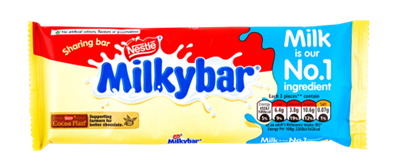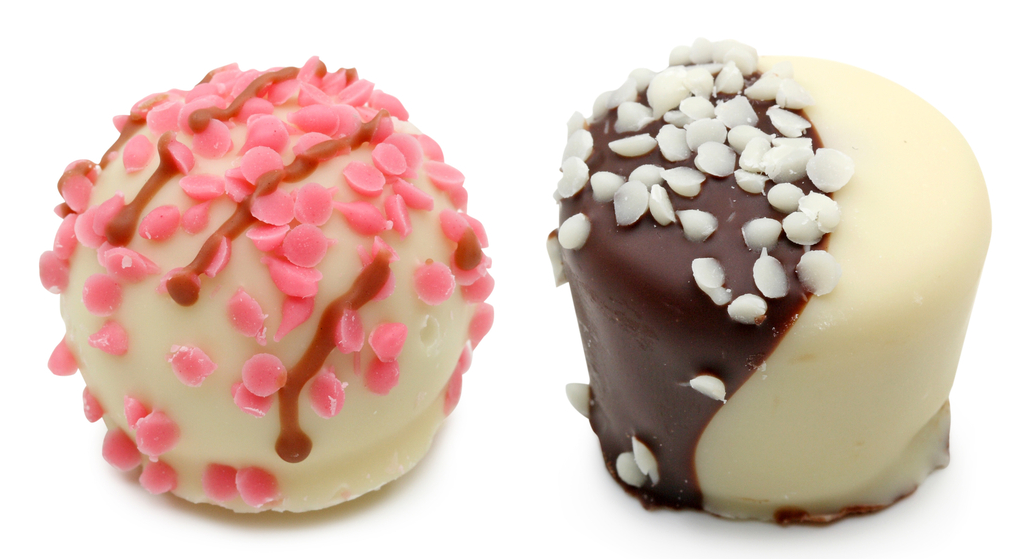The Magic of White Chocolate: The Underdog of Confectionery Design
Yes – we know! Milk and dark chocolate are more popular.
 But from a design standpoint, white chocolate is arguably the most versatile. Its ivory color and unassuming sweetness make it the perfect blank canvas for culinary artistry.
But from a design standpoint, white chocolate is arguably the most versatile. Its ivory color and unassuming sweetness make it the perfect blank canvas for culinary artistry.
But is white chocolate…well…chocolate?
Somewhere, right now, a chocolatier is wrinkling his nose at the mention of white chocolate. “It…is…not…chocolate,” he mutters to himself, affirming his purity and dedication to the cocoa cause.
What is White Chocolate?
It’s true. Unlike dark chocolate and milk chocolate, the pale, creamy substance does not actually contain the chocolate extract that produces the distinctly bitter chocolate flavor. According to AP News, Carl Anderson, one of Nestle Foods Corporation’s vice presidents, states:
“It has many of the flavor notes of milk chocolate but it has a lighter, cleaner taste.”
“But wait!” A farmer steps forward to rebut our angry, purist chocolatier. “White chocolate, like its darker counterparts, is derived from the cocoa bean. Therefore, it’s chocolate.”
A History of White Chocolate
 The introduction of white chocolate dates to the early 20th century, following World War I. The inventor? Henri Nestle, a German-Swiss Chemist. Nestle released the first white chocolate candy bar in 1936, calling it Milky Bar.
The introduction of white chocolate dates to the early 20th century, following World War I. The inventor? Henri Nestle, a German-Swiss Chemist. Nestle released the first white chocolate candy bar in 1936, calling it Milky Bar.
Since that time, it has grown in popularity – and the production of a wide range of white chocolate products followed.
And hey – it even has its own day! The United States celebrates National White Chocolate Day each year on September 22.
How Is White Chocolate Made?
White chocolate is produced using a process similar to that of darker chocolates. Cocoa beans that have been fermented and dried are roasted. The husks of the beans are then cracked open and removed to allow the expression of the cocoa butter. However, unlike dark chocolates, white chocolate formulations exclude cocoa solids.
Due to the lack of bitter solids, the subtle flavor tones of the cocoa butter dominate the taste of the white chocolate. Many people enjoy the mild taste. According to Candy & Snack Today, approximately 17% of millennials prefer white chocolate over darker assortments.
White chocolate can present several variations of white. The absence of all cocoa solids gives the whitest hue. When manufacturing allows some solids to remain, this results in tan colorations. The higher the level of cocoa solids present in a chocolate formulation, the darker the chocolate.
What’s the Official Verdict? Is White Chocolate Really Chocolate?
Contrary to its name, to some, the creamy, sweet delicacy, which contains two to three times as many calories as its brown chocolate counterparts, is not considered actual chocolate. To help provide clarity, the Food and Drug Administration (FDA) officially defined the term through a 1997 proposal. Before the approval of the proposal, white chocolate producers could not officially call their products “chocolate.”
White chocolate, per the FDA standardization, contains no cocoa solids. Moreover, to be considered a chocolate product in the U.S., chocolate formulations may only include cocoa butter-derived fats. The inclusion of vegetable fats is not allowed.
White chocolate ingredients must include at least 20% cocoa butter. Nonetheless, the light-colored confectionery may include milk solids, sweeteners, and other typical, safe ingredients. Ingredient restrictions do not normally hamper the creativity of candy makers. Confectioners can still modify ingredient amounts if they maintain the minimum levels required by regulations.
 Differences Between White Chocolate and White Compound
Differences Between White Chocolate and White Compound
To the layperson, white chocolate and white compound may seem to be interchangeable. The primary ingredient of both substances comes from the cocoa bean. However, there are distinct differences between the two products. Here are a few:
- Vegetable fats. Compound includes vegetable fats, such as palm kernel oil or coconut oil, instead of cocoa butter. White chocolate uses cocoa butter exclusively.
- Melting point. Compound, due to its vegetable fats, melts at a higher temperature, making it chewier and more reluctant to dissolve immediately on the tongue.
- Affordability. Compound is cheaper because its ingredients are less expensive.
- Uses. Compound is more likely to be used in mass-produced commercial products and as chocolate coatings.
Limitless Color and Flavor Opportunities
Because white chocolate presents such an ideal canvas for confectioners, it truly is the best option out there when it comes to design. The scope of what can be done with white chocolate is almost limitless – from adding flavorings and custom coloring to using it for coatings on other snacks.
 White chocolate can be paired with complementary flavors and colored with coordinated hues. Many global brands use this as an opportunity to create spin-off flavor/color combinations. Examples include:
White chocolate can be paired with complementary flavors and colored with coordinated hues. Many global brands use this as an opportunity to create spin-off flavor/color combinations. Examples include:
- Fruit-based combinations:
- Lime & green
- Lemon & yellow
- Strawberry & red or pink
- Blueberry & blue or purple
- Bakery-based combinations:
- Mint
- Pumpkin pie
- Gingerbread
- Butterscotch
- Cinnamon
- Coffee
Even without additional flavorings, white chocolate provides a palatable canvas for seasonal holiday designs, logo enhancements, sports team themes, character-based designs, and nostalgic decorations. Aside from its visual potential, white chocolate is also used to enhance taste and add a decadent mouthfeel when incorporated into snacks such as granola bars, popcorn mixes, cookies, pretzels, protein bars and more.
Colorcon’s wide assortment of colors are specially designed for confectionery applications that include white chocolate. Our oil-based Opatint products are perfect for custom designs where the colors must be matched to a specific custom hue due to brand or application needs.
Have a confectionery color or design project in mind? Let’s talk!